Henry Coller (1886-1958) was a commercial artist and illustrator whose fame rated just a few lines in a couple of post war art directories and also an entry in Who’s Who in Art. My interest in him was aroused because among many other assignments Coller prepared the artwork for five series of cigarette cards issued between 1928 and 1934. These I will come back to a little later.
Born on 21 December 1886 in Wood Green, London, Henry was the son of the Rev W E Coller. It’s a reasonable assumption that Henry shared his father’s faith as his illustrative work in later years included a number of religious paintings. It is also a strong possibility that his father moved from London to Manchester as Henry was educated at Rusholme High School in that city before going on to study art at the Manchester School of Art.
In a series of articles that Coller wrote for The Artist magazine in 1936/37 under the heading ‘My Approach and Methods in Story Illustration’ he revealed some interesting facts, including a desire to be a commercial artist rather than risk the vagaries of trying to get established in ‘fine art’. I quote: “I realized quite early that the readiest and most constant market was for line drawings for press advertising and so my later school of art years were spent in trying to master that most difficult tool, the pen. I concentrated, of course, on the pretty girl (the demand for that elusive being is always there) and I am still trying!”
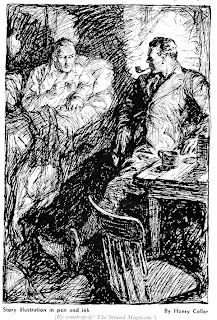
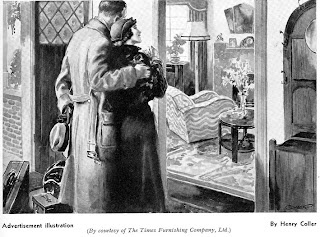
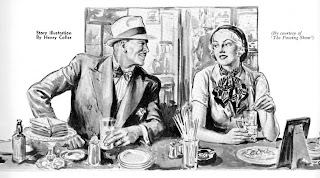
 Apart from that rather sensible early career decision Coller shows that he has a nice sense of humour. This is also apparent from a later statement regarding the type of work he was called upon to do. “For some years I was kept busy making line drawings to advertise every conceivable commodity – soaps, sports outfits, cigarettes, cough cures and baby foods – even a few ‘Kodak’ drawings, until those responsible for that advertising realized that the logical thing to do was to advertise cameras by means of photographs.”
Apart from that rather sensible early career decision Coller shows that he has a nice sense of humour. This is also apparent from a later statement regarding the type of work he was called upon to do. “For some years I was kept busy making line drawings to advertise every conceivable commodity – soaps, sports outfits, cigarettes, cough cures and baby foods – even a few ‘Kodak’ drawings, until those responsible for that advertising realized that the logical thing to do was to advertise cameras by means of photographs.”Whilst Coller admits he was treated well by most of his clients it was apparent then, and I doubt that much has changed today, that not every employer was strictly ethical. Prewar poster designers were probably pre-eminent among commercial artists and commanded the highest fees but some advertisers were obviously keen to get their art on the ‘cheap’. This is how Coller put it: “It is, however, a rather significant fact that although my drawings have been used quite a few times as posters, I have never yet been paid the price of a poster design.”
Nevertheless, Coller was good enough and industrious enough to be kept busy with a variety of assignments. His entry in Who’s Who in Art (6th Edition) lists his specialties as, “sports sketches, drawings of sportsmen, men’s fashions and other advertisements” and among his past work, “designs for Barney’s Tobacco, Times Furnishing, Salute the Soldier (1943-44), Black & White Whisky (1950)”. The publications to which he contributed include Strand, Tatler, Windsor, Wide World, Passing Show, Pearsons, Sketch, Woman & Home, My Home, Women’s Weekly, John Bull, Pictures That Teach and Home Journal.
Books that he illustrated include, Captain of Springdale by Dorita Fairlie Bruce (OUP), The Colour Book of Bible Stories by Joy Wheaton (Ward Lock), White Arab by Percy Westerman (Blackie) and, with others, Mrs Strang’s Annual for Girls (OUP), The Wonder Book of Bible Stories, Moses in the Promised Land and The Life of Jesus, all by David Kyles (Ward Lock), and Picture Stories of the Old Testament by Mary Miller (Lutterworth).
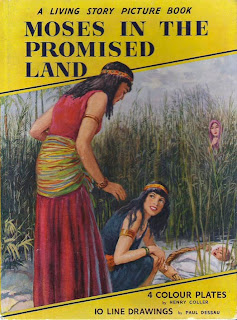
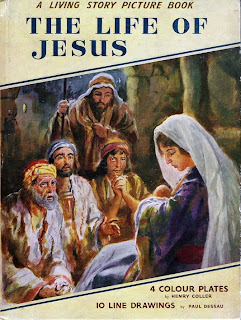
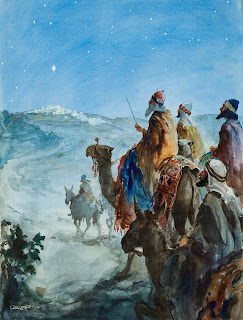
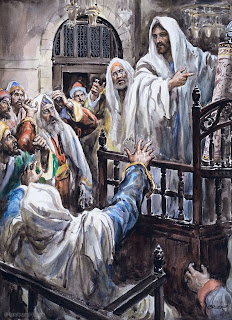 The preponderance of religious books listed above, which probably date from the 1950s, suggest that Henry Coller managed to find a useful niche at a time when sketches for advertisements and magazine stories were starting to dry up. There are a number of religious paintings by Coller illustrated on the Look and Learn website which Steve feels may have been reprinted in Bible Story.
The preponderance of religious books listed above, which probably date from the 1950s, suggest that Henry Coller managed to find a useful niche at a time when sketches for advertisements and magazine stories were starting to dry up. There are a number of religious paintings by Coller illustrated on the Look and Learn website which Steve feels may have been reprinted in Bible Story.But, reverting to the subject that first interested me, cigarette cards, I can only speculate as to how Coller came to be chosen for this work. His entry in Who’s Who in Art mentions ‘drawings of sportsmen’ and I assume that this is a reference to his work for John Player and Lambert & Butler. It is unlikely that he would have been commissioned ‘cold’ for such prestigious work so I think he must have had some previous experience in this field.
In date order of issue the card series are:
Footballers 1928 a series of 50 cards issued by John Player, 1928
Footballers 1928/9 a second series of 25 cards issued by John Player, 1929
Cricketers 1930, a series of 50 cards issued by John Player, 1930
Footballers 1930/1, a series of 50 cards issued by Lambert & Butler, 1931
Hints on Association Football, a series of 50 cards issued by John Player, 1934

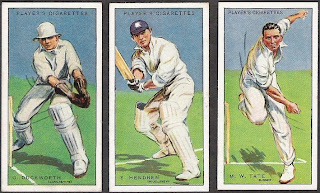
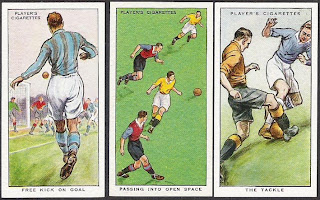 The work involved was onerous, being a total of 225 watercolour sketches, some of which needed revisions, and all required to a strict deadline. These commissions must have kept Coller fully occupied for a considerable time. Despite the pace at which he would have had to work the results were outstanding – particularly the three football series for John Player, which included many action studies. He would have needed photographs of all the players to ensure a reasonable facial likeness and details of the kit worn by the various teams represented. In addition, he would undoubtedly have visited several matches to facilitate an accurate depiction of the postures of the players whilst kicking or running with the ball.
The work involved was onerous, being a total of 225 watercolour sketches, some of which needed revisions, and all required to a strict deadline. These commissions must have kept Coller fully occupied for a considerable time. Despite the pace at which he would have had to work the results were outstanding – particularly the three football series for John Player, which included many action studies. He would have needed photographs of all the players to ensure a reasonable facial likeness and details of the kit worn by the various teams represented. In addition, he would undoubtedly have visited several matches to facilitate an accurate depiction of the postures of the players whilst kicking or running with the ball.I always felt that Coller’s sketches for the series of Cricketers were not quite as successful as for the Football sets that preceded it. Then, a couple of years ago I came across some modern postcards from Karizzma Collectables, which were clearly based on the same artwork that Coller had submitted to Player’s. These, however, had quite different backgrounds to the issued cigarette cards leading me to assume that the printer’s had blocked these out by the use of solid colours of blue and green. The result was that the sense of movement that Coller had so subtly suggested was all but lost. However, even in the cricket series there is much to admire.
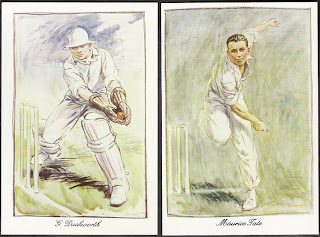 Henry Coller maintained a studio in London and gave an address at 38 Cleveland Square. A photo of him in his studio was published in The Artist magazine. Apart from his commercial work he found time to exhibit at the Royal Academy and also to paint portraits. One of these of Baron Pethick-Lawrence is in the collection of the National Portrait Gallery, London. He was a member of both the Chelsea Arts and London Sketch Clubs. He was married with four children and died in 1958.
Henry Coller maintained a studio in London and gave an address at 38 Cleveland Square. A photo of him in his studio was published in The Artist magazine. Apart from his commercial work he found time to exhibit at the Royal Academy and also to paint portraits. One of these of Baron Pethick-Lawrence is in the collection of the National Portrait Gallery, London. He was a member of both the Chelsea Arts and London Sketch Clubs. He was married with four children and died in 1958.(* A couple of additional notes: William Edward Coller was born in Trowbridge, Wiltshire, and was a schoolmaster in Blackburn, Lancashire, where the first two children of his children, Frederick Ernest W. (1876- ) and Ethel Jane (1880- ), were born. His wife, Jane (nee Watts, whom he had married in 1874), died in early 1880 at the age of 40, and W. E. Coller was married later that year to Elizabeth Anne Whitehead. Three further children followed, William Lonsdale (1882- ), born in Blackburn, and Edward (1884- ) and Henry, both born in Wood Green.
W. E. Coller continued to teach as a private tutor in English, Latin and French, but was also a Congregational Minister; in 1891 the family were living at Chorlton on Medlock, Manchester, in Lancashire; by 1901 they had moved to Moss Side, Manchester. Hence Henry Coller's attendance of a Manchester school.)













































As always, Steve an excellent Blog.
ReplyDeleteI never realised his family origins are the same as my own.
Hope you are well.
Keep up the great work.
Best Wishes,
Tim...
;D
Thank you for the history lesson. I have several sets of the 1934 Hints on Association Football, which I purchased specifically because of the wonderful art work. I much prefer these Players sets to the black-and-white photo sets of the same era.
ReplyDeleteCan anyone tell me the relationship of Jane Watts to Sir Philip Watts, FRS, the naval architect? I suspect they were siblings.
ReplyDeleteJust read the blog - my late mother-in-law was used by Coller as a model for "The Right Kind of Girl" by Dorothea Moore. I have a copy of the book that Coller signed and gave to my mother-in-law. Just wanted to find out more about him.
ReplyDeleteThe answer to my question is yes, Jane and Philip Watts were siblings.
ReplyDeleteHarry Coller used his nephew and niece, Deryck and Kathleen Le Mare, as models for his advertisement drawings for Barbours of South Shields. They were published in Punch in the 1930s.
Could this be the H Coller who has four illustrations in the book Seven Sisters at Queen Anne's (Blackie, c 1923)- the first of a set of three titles about this family at Queen Anne's School? Looks like his style. I would attach a scan but can't see how.
ReplyDeleteHi Pamish,
ReplyDeleteProbably... it's certainly the right era and the right subject matter, so I can't it would be anybody else.
Is there any reference to sketches he did of males smoking pipes head only.
ReplyDeleteI have found 4 sketches that belonged to my great granddads brother
ReplyDeleteHow can I find out if they are originals. They are signed coller
Hi, i have the same prints of pipe smokers. I think it's for Barney's tobacco. I have a set of 13 and am looking for more info on them. Please let me know if anything comes up and vice versa, Jessie
DeleteI have found out some information about these prints. I have 10 with 9 being men and 1 being a woman smoking a pipe. You are correct in thinking these are for Barney’s Tobacco and I have been able to confirm this. Firstly, I found 4 ads on ebay selling old paper clippings of adverts for Barney’s tobacco and 2 of the sketches match 2 that I have in my possession. Also, I have the original envelope that they came in when they were sent to my great-aunt. This envelope was franked March 1934 and the address label had “from the National Sales Bureau of…. John Sinclair Ltd”. John Sinclair Ltd owned Barney’s Tobacco so we can confirm that these portraits were part of an advertising campaign for Barney’s Tobacco. I would be interested to know which prints you have just to see how many were done.
DeleteAn excellent bit of detective work! Well done.
DeleteGreat Research and really interesting.
ReplyDeleteI have recently acquired what appears to be an original by Henry Coller dated 1921 and titled "NANCY"
I would really like to try and find more information does anyone have anysuggestions?